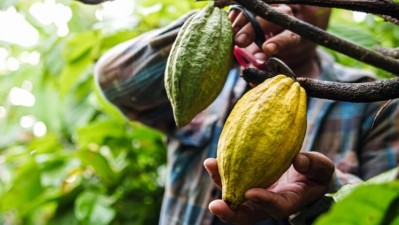New approach puts farmers at the center of crop testing
A new research study between the Alliance of Bioversity International and the International Centre for Tropical Agriculture has discovered technology that enables farmers to test new crop varieties and enhance food security in their local areas.
Published in the Crop Science Journal in July 2024, the research explores a new technological method for producing better crop varieties worldwide, providing potential solutions for cocoa farmers and the wider confectionery community.
Food security is increasing around the globe. A total of 345 million people in 82 countries were suffering acute food insecurity in 2022. As part of their efforts to explore ways to address insecurity and secure the future of food, the study’s researchers sought to test and roll out new crop varieties adapted to changing local conditions that reflect local needs and capabilities.
Researchers at the Alliance of Bioversity International and CIAT and their collaborators have worked with farmers for over a decade to find better ways to test new crop varieties. Until recently, farmers and agricultural researchers struggled to agree on methods to support this aim, prompting the researchers’ study, they state.
What is the tricot method?
The tricot method in agriculture is a participatory approach used to evaluate and compare agricultural technologies or practices. It involves farmers testing different options (e.g., crop varieties, fertilizers, or pest control methods) on their own fields and ranking them based on their performance. The method uses a three-cornered comparison system, where participants rate options as "better," "same," or "worse" in relation to each other. This simple but effective approach allows for large-scale data collection from multiple sites while giving farmers a voice in selecting the best practices suited to their local conditions. It helps ensure that agricultural innovations are practical and relevant to those who implement them.
A new way to farm
Novel technologies were at the forefront of the researchers’ study. “The tricot method, also known as the triadic comparison of technologies, responds to the need to involve farmers more actively in agricultural research, particularly in evaluating crop varieties and agricultural technologies,” says Jacob van Etten, Principal Scientist and Director of the Digital Inclusion research programme at the Alliance of Bioversity International and CIAT.
Unlike the tricot method used in the recent research study, traditional agricultural research often excludes smallholder farmers from the decision-making process, leading to recommendations that may not suit local conditions or farmer preferences.
The tricot method was developed to address this gap by leveraging the knowledge and experience of farmers, enabling them to test and compare different tech on their farms. It also tackles the need to make agricultural research more scalable, cost-effective and relevant to farmers’ diverse environments and needs in different regions. A digital platform underpins the technology’s trial design and data collection.
“Tricot addresses a paradox,” van Etten says. “Farmers love to experiment, but when researchers come and design trials on their farms, farmers disengage,” van Etten adds. Usually, crop varieties are planted in complex patterns, which only trained field workers can do. “Farmers do not really feel ownership of the trial,” Van Etten continues.
“We combined attention to farmers’ motivation with digital design to come up with a tricot,” says van Etten. With this tech, the researchers found that farmers have more ownership over their trials. “Usually, farmers return highly accurate data and would like to do another round of tricot trials,” van Etten notes from the team’s research findings.
Farmers and tech collaborate
Working together, farmers and tech can achieve what is impossible on their own. “Researchers could never expose their technologies to realistic, diverse testing environments in a cost-efficient way without collaboration from farmers,” van Etten confirms.
Instead of imitating those conditions in complex experiments, tricot tech can cut through that complexity and put crop varieties directly in their prospective use environment.
“Farmers do not have access to the same range of crop varieties as researchers do,” van Etten adds. They also don’t have the time or resources to select varieties that do better under a range of circumstances, as they only see what happens on their own farm. Every season is just one data point. Researchers can mobilise larger groups of farmers, however, helping them compare their data and give farmers access to a larger pool of crop diversity.
In the study, researchers found that tricot tech is more cost-effective than previous approaches, involves groups of farmers and larger, commonly managed plots. From a farmers’ perspective, it is also as effective as these approaches in predicting the performance of varieties in upcoming seasons, the researchers found.
Developing cocoa and confectionery products
The researchers’ findings can impact the wider cocoa and confectionery sector by anticipating and helping to overcome climatic factors. “In the cacao sector, farmers usually receive a mix of varieties to plant on their farms,” van Etten says. This happens in Ghana, for example, one of the leading global cacao producers.
“This strategy is expected to address the diverse climatic conditions that cocoa faces,” says van Etten. The different varieties respond in various ways to stresses, so some will always produce. Having these mixes gives little insight into the specific response of new cocoa varieties, however it does, to its local conditions.
Farmers don’t know which tree is which variety. “If farmers would test different specific varieties on their farms, they could possibly help researchers to get better insights and accelerate the adaptation of cocoa production systems to climate change,” says van Etten. This does not mean that Ghana would give up on the idea of having farmers grow mixes of the varieties. Farmers could therefore still grow mixes of the best-identified varieties.
“However, for testing on small plots, farmers would split out the different varieties to assess each one separately,” says van Etten. The Alliance of Bioversity International and CIAT and the Cocoa Research Institute of Ghana (CRIG) have an ongoing trial to test this idea.
Developing citizen on-farm science to develop better crop varieties
The researchers of this latest study state that as more of the scientific community and private extension networks use tricot globally, more benefits from involving farmers are emerging.
A 2024 study involved hundreds of common bean smallholder farmers from 140 villages in the Trifinio region of El Salvador, Guatemala, and Honduras, evaluated tricot, a group-based participatory variety testing approach and a control approach to evaluate the effectiveness of the different approaches.
The study’s first author and Postdoctoral Associate at the School of Integrative Plant Science, at Cornell University, Martina Occelli, says the researchers found that national programmes can benefit from the cost-effective, equitable, externally valid, and scalable nature of citizen science on-farm testing approach to inform breeding programmes.
“A citizen science on-farm testing approach should be used for on-farm testing, and a group-based agronomy training could be delivered separately, for example, to farmers who have gone through one round of citizen science on-farm testing,” Occelli says. The lead researchers also state that adding a hybrid approach would lead to fewer farmers dropping out of the trial and increase data value.
In another 2024 paper, “The tricot approach: an agile framework for decentralised on-farm testing supported by citizen science. A retrospective,” researchers detailed that critical issues remain with the tricot method. Among these are how to sustain enthusiasm, skills and financing among the scientific, technical and farmer communities. The aim is to help make tricot participants become more representative of the gender and other socio-economic diversity found in farming communities.
A July 2024 study from Uganda showed that applying the tricot methodology enabled researchers to consider crop-specific information and farmers’ culinary preferences for their crops, such as taste and cookability.
Tricot tech is now mature enough for the scientific community to consider how further research can organise farmer networks in a scalable way, build up experience and be more farmer-focused. “We are still doing methodological research on how we can design trials in a way that farmers can get out of it what they want to,” van Etten says. If research becomes more farmer-driven, this can help guide agronomical research’s technological focus.
Source: Aguilar, E., Peterson, T. C., Obando, P. R., Frutos, R., Retana, J. A., Solera, M., Soley, J., García, I. G., Araujo, R. M., Santos, A. R., Valle, V. E., Brunet, M., Aguilar, L., Álvarez, L., Bautista, M., Castañón, C., Herrera, L., Ruano, E., Sinay, J. J., … Mayorga, R. (2005). Changes in precipitation and temperature extremes in Central America and northern South America, 1961–2003. Journal of Geophysical Research: Atmospheres, 110(D23). https://doi.org/10.1029/2005jd006119
















